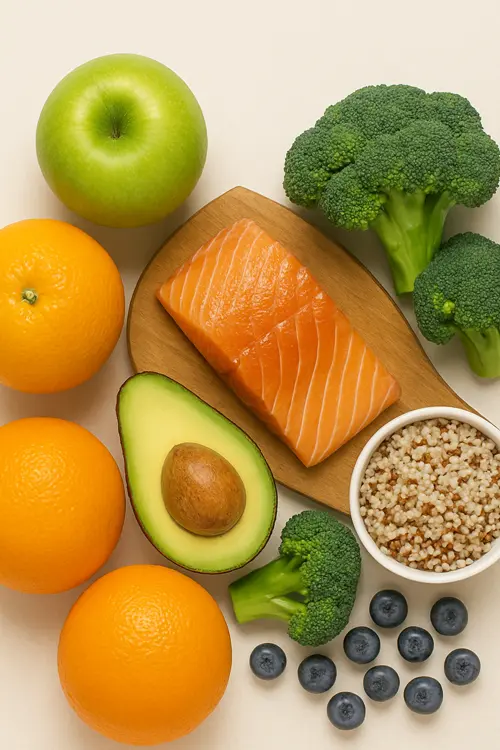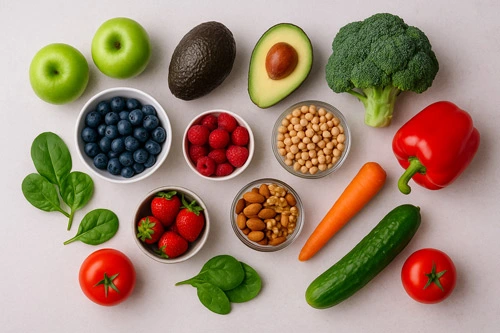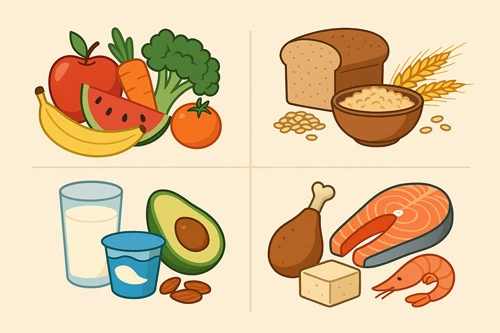Introduction: What is the Hashimoto Diet and Why It Matters?
Living with Hashimoto’s thyroiditis can feel overwhelming. Fatigue, weight gain, depression, and brain fog are just a few of the symptoms people with this autoimmune thyroid disorder often struggle with. While there is no cure for Hashimoto’s, many individuals have found relief and better management of symptoms through a targeted eating plan known as the Hashimoto diet.
The Hashimoto diet is more than just a trend — it’s a lifestyle designed to support thyroid health, reduce inflammation, and balance the immune system. Unlike generic diets, this one is personalized to address the specific nutritional needs and sensitivities of those with Hashimoto’s thyroiditis. From eliminating common triggers like gluten and dairy to incorporating nutrient-rich, anti-inflammatory foods, this approach can make a significant difference.
In this guide, we’ll walk you through everything you need to know about the Hashimoto diet — especially if you’re a beginner. You’ll discover a free 7-day meal plan, learn what foods to eat and avoid, explore easy Hashimoto-friendly recipes, and even find weight loss strategies tailored to thyroid health. Whether you’re newly diagnosed or have been managing your symptoms for years, this complete guide will help you take control of your health — one meal at a time.
🔹 Section 1: What Is the Hashimoto Diet?
What Is the Hashimoto Diet?
The Hashimoto diet is a strategic, anti-inflammatory eating plan specifically designed to support individuals with Hashimoto’s thyroiditis, an autoimmune disorder that attacks the thyroid gland and can lead to hypothyroidism. Unlike generic low-calorie or trendy diets, this dietary approach focuses on reducing autoimmune triggers, improving gut health, and providing the nutrients needed to optimize thyroid function.
Hashimoto’s thyroiditis is not just a thyroid issue — it’s an immune system problem. When the immune system becomes overactive and starts attacking the thyroid tissue, it causes inflammation and a drop in hormone production. This leads to symptoms like chronic fatigue, weight gain, depression, constipation, cold intolerance, and brain fog.
Here’s where the Hashimoto diet plan becomes crucial: by eliminating inflammatory foods and focusing on nutrient-dense, healing foods, this diet helps calm the immune system, support hormone production, and improve overall quality of life.
Core Principles of the Hashimoto Diet Plan
The Hashimoto diet for beginners can feel overwhelming at first, but once you understand the basic principles, it becomes manageable — and often life-changing:
1. Remove Common Triggers
-
Gluten: One of the most widely eliminated ingredients in a Hashimoto diet. Studies show that gluten may increase intestinal permeability (leaky gut) and trigger autoimmune reactions in susceptible individuals.
-
Dairy: A frequent source of inflammation and digestive issues.
-
Soy: Contains compounds that may interfere with thyroid function.
-
Refined sugar and processed foods: Promote inflammation and blood sugar imbalances.
2. Focus on Anti-Inflammatory Foods
The goal is to calm the immune system. Include:
-
Leafy greens (e.g., spinach, kale)
-
Cruciferous vegetables (in moderation and well-cooked)
-
Wild-caught fish (rich in omega-3s)
-
Bone broth, berries, turmeric, ginger
-
Gluten-free whole grains like quinoa or buckwheat
3. Balance Blood Sugar
Maintaining stable blood sugar levels is essential to reducing stress on the thyroid and adrenal glands.
-
Prioritize protein and healthy fats in every meal
-
Avoid skipping meals
-
Reduce high-glycemic carbs and sugary snacks
4. Support Gut Health
Leaky gut is often associated with autoimmune diseases. Healing the gut through diet can reduce autoimmune activity.
-
Include fermented foods like sauerkraut and kimchi
-
Consider a probiotic supplement if needed
-
Avoid irritants like alcohol and artificial sweeteners
Who Should Follow the Hashimoto Diet?
This diet is especially beneficial for people who:
-
Have been diagnosed with Hashimoto’s thyroiditis
-
Experience symptoms of hypothyroidism
-
Have other autoimmune conditions (like celiac or rheumatoid arthritis)
-
Struggle with weight gain, brain fog, or unexplained fatigue
It’s also a smart approach for those looking for an anti-inflammatory, thyroid-friendly lifestyle — not just a temporary diet.
Final Thoughts on This Section
The Hashimoto diet plan is not one-size-fits-all. While there are common patterns (like going gluten- and dairy-free), the best results often come from personalized experimentation — eliminating foods for a few weeks and reintroducing them to test reactions.
In the next section, we’ll explore the benefits of following a Hashimoto diet and how it can change your health from the inside out.
learn more: Anti Inflammation Diet: Best Foods, Recipes, and Plans to Fight Inflammation
🔹 Section 2: Benefits of the Hashimoto Diet
How the Hashimoto Diet Can Transform Your Health
If you’ve been living with Hashimoto’s thyroiditis, you probably know how frustrating and unpredictable the symptoms can be. The fatigue, unexplained weight gain, mental fog, and sensitivity to cold aren’t just annoying — they can seriously impact your quality of life. While medications like levothyroxine help regulate thyroid hormones, they often don’t address the root cause of Hashimoto’s: chronic inflammation and immune system dysfunction.
That’s where the Hashimoto diet comes in.
The right nutritional strategy can reduce autoimmune activity, restore gut integrity, and support optimal thyroid function — all while helping you feel more energetic and in control.
Let’s dive into the top benefits.
1. Reduces Chronic Inflammation
One of the most significant benefits of the Hashimoto diet is its anti-inflammatory focus. By eliminating inflammatory foods like gluten, dairy, refined sugars, seed oils, and processed snacks, and replacing them with healing foods like leafy greens, berries, omega-3-rich fish, and turmeric, this diet helps calm the body’s overactive immune response.
This is why the anti-inflammatory diet for Hashimoto’s thyroiditis is so effective in easing symptoms.
2. Supports Gut Healing
A compromised gut lining (often referred to as “leaky gut”) is strongly associated with autoimmune diseases, including Hashimoto’s. The Hashimoto diet emphasizes foods that nourish the gut microbiome and repair the intestinal barrier.
These include:
-
Bone broth
-
Fermented foods (like kimchi and sauerkraut)
-
High-fiber vegetables
-
Collagen-rich meals
-
Gluten- and dairy-free choices
By healing the gut, the immune system becomes less reactive — and symptoms often subside.
3. Boosts Energy and Mental Clarity
Fatigue and brain fog are two of the most common complaints among those with Hashimoto’s. The Hashimoto diet eliminates foods that stress the body (like high-sugar or high-caffeine foods) and replaces them with blood-sugar-balancing, nutrient-dense meals.
More stable energy = clearer mind + fewer afternoon crashes.
4. Encourages Healthy Weight Loss
Even with normal thyroid lab results, many people with Hashimoto’s struggle to lose weight. That’s because the body is in a pro-inflammatory, hormonal imbalance state.
By following a Hashimoto diet plan to lose weight, which is high in clean protein, healthy fats, fiber, and free from inflammatory ingredients, your body starts to rebalance hormones and burn fat more efficiently. More on this in Section 4!
5. Supports Immune System Balance
Rather than “boosting” the immune system (which can be risky in autoimmune conditions), the Hashimoto diet works to modulate immune function — calming overactivity without suppressing it.
Nutrients that support this balance include:
-
Selenium (found in Brazil nuts)
-
Zinc (pumpkin seeds, shellfish)
-
Vitamin D (sunshine + food)
-
Omega-3s (wild-caught fish, chia seeds)
🔹 Section 3: Hashimoto Diet Food List – What to Eat and What to Avoid
Why a Food List Matters
When starting the Hashimoto diet, one of the most helpful tools is a clear food list. Knowing what to eat and what to avoid can make meal planning easier, reduce stress around food choices, and prevent unintentional inflammation or autoimmune flare-ups.
This section offers a comprehensive Hashimoto diet food list that focuses on nutrient-dense, anti-inflammatory ingredients — while eliminating foods that are commonly linked to thyroid dysfunction, leaky gut, and immune system overstimulation.
Hashimoto-Friendly Foods: What to Eat
These are the foods you should prioritize. They’re rich in vitamins, minerals, antioxidants, and healthy fats that support the thyroid, immune system, and gut health.
Lean Proteins
-
Grass-fed beef
-
Organic chicken and turkey
-
Wild-caught fish (especially salmon, sardines, cod)
-
Eggs (if no sensitivity)
-
Bone broth
Healthy Fats
-
Avocados and avocado oil
-
Extra virgin olive oil
-
Coconut oil (helps metabolism)
-
Nuts and seeds (almonds, walnuts, chia, flax, hemp)
-
Fatty fish (omega-3s)
Non-Starchy Vegetables
-
Leafy greens (spinach, kale, arugula)
-
Zucchini, bell peppers, cucumbers
-
Carrots, beets, cauliflower, sweet potato
-
Cruciferous vegetables (broccoli, cabbage) — must be cooked, not raw
Fruits (In Moderation)
-
Berries (blueberries, raspberries)
-
Apples, pears, papaya
-
Bananas (green or half-ripe are best)
-
Pomegranate, kiwi, citrus fruits
Gluten-Free Grains & Alternatives
-
Quinoa
-
Buckwheat
-
Brown rice
-
Cassava, tapioca, arrowroot
-
Gluten-free oats
Fermented & Gut-Healing Foods
-
Sauerkraut
-
Kimchi
-
Coconut yogurt (unsweetened)
-
Kombucha (low sugar)
-
Collagen peptides, gelatin, L-glutamine supplements
Herbs & Spices
-
Turmeric
-
Ginger
-
Rosemary, basil, oregano
-
Cinnamon and cloves
Foods to Avoid on the Hashimoto Diet
Certain foods can trigger inflammation, damage the gut lining, or interfere with thyroid hormone conversion. Even if you don’t notice immediate symptoms, these foods may contribute to long-term immune imbalance.
Gluten-Containing Grains
-
Wheat
-
Barley
-
Rye
-
Spelt
-
Farro
Even small amounts of gluten can trigger autoimmune reactions — many experts recommend 100% gluten elimination.
Dairy Products
-
Milk, cheese, cream
-
Yogurt (except dairy-free alternatives)
-
Casein and whey protein powders
Soy Products
-
Soy milk, tofu, soy sauce, edamame
-
Processed vegan meat replacements made with soy protein
Refined Sugar & Artificial Sweeteners
-
White/brown sugar
-
Corn syrup, fructose, cane juice
-
Aspartame, sucralose, saccharin
Processed and Fried Foods
-
Packaged snacks, chips, crackers
-
Fried foods, fast food
-
Foods with hydrogenated oils or industrial seed oils (canola, soybean oil, sunflower oil)
Alcohol & Caffeine (Limit)
-
Alcohol can damage the gut lining and impair liver detox
-
Caffeine in excess may stress the adrenal glands and worsen anxiety or insomnia
Tips for Shopping and Cooking
-
Read food labels carefully — especially for gluten and dairy
-
Cook from scratch when possible to control ingredients
-
Choose organic and grass-fed products when budget allows
-
Keep a symptom journal to track how your body reacts to specific foods
learn more: Plant-Based Diet: A Complete Guide to Benefits, Foods & Weight Loss
🔹 Section 4: Hashimoto Diet for Weight Loss – Why It’s Different (and How to Make It Work)
Why Losing Weight with Hashimoto’s Is So Challenging
Many people with Hashimoto’s thyroiditis struggle with unexplained weight gain and frustrating weight loss resistance — even when they follow traditional low-calorie diets. That’s because Hashimoto’s doesn’t just affect the thyroid — it disrupts your entire metabolic system.
When thyroid hormone levels drop (or fluctuate), the body’s metabolism slows down, which means you burn fewer calories at rest. Add in chronic inflammation, nutrient deficiencies, hormone imbalances, and often fatigue-driven inactivity, and you’ve got the perfect storm for stubborn weight gain.
So, what’s the solution? The Hashimoto diet plan to lose weight is not about restriction — it’s about healing your body from the inside out to reset metabolism naturally.
Key Principles of a Hashimoto Weight Loss Plan
1. Focus on Nutrient Density, Not Calorie Cutting
Instead of starving your body, you want to flood it with healing nutrients:
-
Lean proteins to support muscle and metabolism
-
Anti-inflammatory fats to regulate hormones
-
Fiber-rich vegetables to balance blood sugar and support digestion
Aim for balanced meals that contain protein + fat + fiber every time you eat.
2. Eliminate Inflammatory Triggers
Chronic inflammation puts the body into a “danger mode,” making it hold on to fat, especially around the midsection. Remove common culprits:
-
Gluten
-
Dairy
-
Refined sugar
-
Seed oils (soybean, corn, canola)
-
Highly processed packaged foods
This is where the anti-inflammatory diet for Hashimoto’s thyroiditis overlaps perfectly with weight loss goals.
3. Support Blood Sugar and Insulin Sensitivity
Blood sugar spikes = insulin surges = fat storage.
Instead of high-carb meals and snacks, opt for:
-
Low-glycemic fruits (berries, apples)
-
Complex carbs (quinoa, sweet potatoes)
-
Healthy fats and proteins to slow digestion
This not only supports weight loss but also reduces brain fog and fatigue.
4. Don’t Skip Meals — Especially Breakfast
Skipping meals (especially breakfast) can send stress signals to your body, raising cortisol and slowing metabolism further.
Start your day with a protein-rich breakfast — for example:
-
Eggs with spinach and avocado
-
Smoothie with collagen, chia seeds, and berries
5. Prioritize Sleep and Stress Reduction
Poor sleep and chronic stress are major obstacles to weight loss, especially with autoimmune conditions. High cortisol (the stress hormone) promotes belly fat and thyroid hormone resistance.
Tips:
-
Aim for 7–9 hours of sleep nightly
-
Avoid screens before bed
-
Practice deep breathing, yoga, or nature walks
6. Gentle, Consistent Movement
People with Hashimoto’s often feel exhausted, so intense workouts can be counterproductive. Instead, focus on:
-
Daily walking
-
Pilates or yoga
-
Light strength training
Movement should energize you — not drain you.
Sample Hashimoto Diet Meal Plan for Weight Loss (Day Example)
| Meal | Example |
|---|---|
| Breakfast | Scrambled eggs + avocado + sautéed spinach |
| Snack | Handful of walnuts + green tea |
| Lunch | Grilled chicken over quinoa and roasted veggies |
| Snack | Coconut yogurt + blueberries |
| Dinner | Baked salmon + steamed broccoli + olive oil drizzle |
Final Thoughts
If you’ve tried and failed to lose weight with Hashimoto’s, it’s not your fault. Standard diets often don’t account for the unique hormonal and metabolic challenges that come with thyroid disorders.
The good news? With the right Hashimoto diet for weight loss — one that calms inflammation, nourishes your thyroid, and balances blood sugar — your body can finally start letting go of the weight it’s been holding onto for years.
👉 In the next section, we’ll dive into a complete 7-day Hashimoto diet meal plan to get you started.
learn more: Diet Soda: Benefits, Risks, Ingredients & Weight Loss Insights
🔹 Section 5: 7-Day Diet Plan for Hashimoto’s Disease
Eating the right foods consistently is key to managing Hashimoto’s symptoms and supporting thyroid health. This 7-day meal plan focuses on nutrient-dense, anti-inflammatory, and thyroid-supportive foods. It’s gluten-free, dairy-free (but you can adjust if you tolerate some dairy), and designed to balance blood sugar and reduce inflammation.
Day 1
-
Breakfast:
Avocado and scrambled eggs on gluten-free toast with a side of sautéed spinach. -
Snack:
A handful of Brazil nuts (rich in selenium) and a green tea. -
Lunch:
Quinoa salad with grilled chicken, mixed greens, cherry tomatoes, cucumber, and olive oil dressing. -
Snack:
Carrot sticks with hummus. -
Dinner:
Baked wild-caught salmon with steamed broccoli and roasted sweet potatoes.
Day 2
-
Breakfast:
Chia seed pudding made with coconut milk, topped with blueberries and flaxseeds. -
Snack:
Apple slices with almond butter. -
Lunch:
Turkey lettuce wraps with avocado, shredded carrots, and sliced bell peppers. -
Snack:
Cucumber slices and a small portion of sauerkraut. -
Dinner:
Stir-fried grass-fed beef with zucchini noodles and garlic-ginger sauce.
Day 3
-
Breakfast:
Smoothie with collagen peptides, spinach, banana (half-ripe), and unsweetened almond milk. -
Snack:
A boiled egg and handful of walnuts. -
Lunch:
Roasted vegetable bowl with quinoa, kale, roasted beets, and pumpkin seeds. -
Snack:
Coconut yogurt (unsweetened) with a sprinkle of cinnamon. -
Dinner:
Grilled chicken breast with steamed asparagus and cauliflower rice.
Day 4
-
Breakfast:
Omelette with mushrooms, tomatoes, and fresh herbs. -
Snack:
Fresh berries and a few sunflower seeds. -
Lunch:
Salmon salad with mixed greens, avocado, olives, and lemon vinaigrette. -
Snack:
Celery sticks with guacamole. -
Dinner:
Slow-cooked bone broth soup with vegetables and herbs.
Day 5
-
Breakfast:
Sweet potato hash with onions, bell peppers, and turkey sausage. -
Snack:
Handful of mixed nuts and herbal tea. -
Lunch:
Zucchini noodles with homemade tomato sauce and ground turkey. -
Snack:
Sliced pear with cinnamon. -
Dinner:
Roasted duck breast with Brussels sprouts and sautéed kale.
Day 6
-
Breakfast:
Buckwheat pancakes topped with fresh strawberries and a drizzle of raw honey. -
Snack:
Carrot and cucumber sticks with tahini dip. -
Lunch:
Grilled shrimp salad with avocado, mango, and arugula. -
Snack:
A small bowl of mixed olives. -
Dinner:
Baked cod with lemon, garlic, and steamed green beans.
Day 7
-
Breakfast:
Smoothie bowl with spinach, frozen berries, chia seeds, and coconut flakes. -
Snack:
A hard-boiled egg and a few almonds. -
Lunch:
Chicken and vegetable stir-fry with broccoli, carrots, and snap peas. -
Snack:
Fresh pineapple chunks. -
Dinner:
Grass-fed beef stew with root vegetables and herbs.
🔹 Section 6: Hashimoto Diet Recipes
1. Sweet Potato Breakfast Hash
Ingredients:
-
1 medium sweet potato, diced
-
1/2 onion, chopped
-
1 bell pepper, diced
-
2 cloves garlic, minced
-
1 tsp olive oil
-
Salt and pepper to taste
-
2 eggs (optional)
Instructions:
-
Heat olive oil in a skillet over medium heat.
-
Add onion and garlic; sauté until fragrant.
-
Add diced sweet potatoes and bell pepper. Cook until tender (about 10-15 minutes).
-
Season with salt and pepper.
-
In a separate pan, cook eggs as desired (scrambled or fried).
-
Serve sweet potato hash topped with eggs.
2. Turmeric Chicken and Quinoa Bowl
Ingredients:
-
1 cup cooked quinoa
-
1 chicken breast, sliced
-
1 tsp turmeric powder
-
1 tsp cumin
-
1 tbsp olive oil
-
Mixed greens
-
Lemon juice
-
Salt and pepper
Instructions:
-
Marinate chicken with turmeric, cumin, salt, and pepper.
-
Heat olive oil in a pan; cook chicken until fully done.
-
Serve chicken over quinoa with mixed greens and a squeeze of lemon juice.
3. Bone Broth Vegetable Soup
Ingredients:
-
4 cups bone broth (chicken or beef)
-
1 carrot, diced
-
1 celery stalk, diced
-
1 cup kale or spinach
-
1 garlic clove, minced
-
Salt and pepper
Instructions:
-
In a pot, bring bone broth to a boil.
-
Add carrots, celery, and garlic; simmer for 15 minutes.
-
Add kale or spinach and cook for an additional 5 minutes.
-
Season with salt and pepper. Serve warm.
4. Gluten-Free Banana Almond Muffins
Ingredients:
-
2 ripe bananas
-
1 ½ cups almond flour
-
2 eggs
-
1 tsp baking soda
-
1 tsp vanilla extract
Instructions:
-
Preheat oven to 350°F (175°C).
-
Mash bananas in a bowl.
-
Mix in eggs and vanilla.
-
Add almond flour and baking soda; stir until combined.
-
Spoon mixture into muffin tin lined with paper cups.
-
Bake for 20-25 minutes until golden brown.
🔹 Section 7: Free Resources & Printable Plan
Free Hashimoto Diet Plan PDF & Trusted Resources
Starting a new diet can feel overwhelming, so having easy-to-follow resources is essential. To support your journey, many health experts and organizations offer free downloadable Hashimoto diet plans that outline daily meals, shopping lists, and tips tailored specifically for thyroid health.
Here are some trusted sources where you can find free or low-cost plans:
-
Dr. Izabella Wentz’s website — a leading Hashimoto’s expert who provides meal plans, recipes, and guides.
-
Autoimmune Protocol (AIP) communities — focused on anti-inflammatory eating that often overlaps with Hashimoto-friendly diets.
-
National Institutes of Health (NIH) — offers educational resources about autoimmune diseases and nutrition.
Additionally, creating your own printable meal plan helps track your progress and stay consistent. Consider downloading a free Hashimoto diet meal plan PDF that you can print or keep on your phone for quick reference.
Tip: When selecting resources, always ensure they are backed by science or come from certified health professionals to avoid misinformation.
🔹 Section 8: Top Hashimoto Diet Books
Must-Read Books for the Hashimoto Diet
If you want to deepen your understanding of how diet impacts Hashimoto’s thyroiditis and get expert guidance, these books are highly recommended by the thyroid community:
-
“The Hashimoto’s Protocol” by Dr. Izabella Wentz
A comprehensive guide by a leading thyroid specialist who shares her own journey and science-backed protocols to heal Hashimoto’s naturally through diet, supplements, and lifestyle changes. -
“Hashimoto’s Food Pharmacology” by Dr. Izabella Wentz
This book focuses specifically on how food can be used as medicine to reduce autoimmune attacks and improve thyroid function, including recipes and meal plans. -
“The Root Cause” by Amy Myers, MD
A holistic approach to reversing autoimmune disease by identifying and eliminating triggers, with detailed nutritional advice tailored for thyroid health. -
“Hashimoto’s Thyroiditis: Lifestyle Interventions for Finding and Treating the Root Cause” by Dr. Izabella Wentz
Explores lifestyle changes, including diet, that can transform your health.
🔹 Conclusion: Taking Control with the Hashimoto Diet
Living with Hashimoto’s thyroiditis can be challenging, but the right diet can make a profound difference in managing symptoms and improving quality of life. The Hashimoto diet is not just about what you avoid—it’s about nourishing your body with anti-inflammatory, nutrient-dense foods that support thyroid function, balance your immune system, and promote gut health.
By following a well-structured plan—like the 7-day diet plan for Hashimoto’s disease—and focusing on personalized choices, you can reduce inflammation, boost your energy, and even achieve sustainable weight loss. Incorporating healing recipes, maintaining balanced blood sugar, and choosing the right supplements can accelerate your progress.
Remember, managing Hashimoto’s is a journey that involves patience and self-compassion. Use the resources, meal plans, and expert books available to educate yourself and empower your healing. Whether you’re a beginner or have been navigating this condition for years, adopting a Hashimoto diet can transform how you feel inside and out.
Take the first step today by implementing small changes, listening to your body, and embracing a lifestyle that prioritizes your thyroid health.






